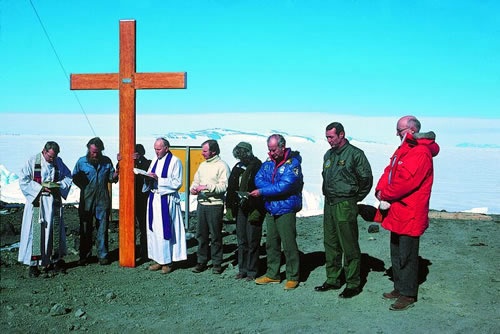
Memorial service at Scott Base on 2 December 1979. Left to right: US Navy Chaplain, Garth Varcoe, Bob Dunnachie (obscured), Father Creagh, Mike Prebble, unknown, Bob Thomson (superintendent of the Antarctic Division of the Department of Scientific and Industrial Research), Captain Westbrook, unknown.
Initial memorials and memorial services
At midday on 29 November, just before confirmation was received that no one had survived the crash of TE901, memorial masses were held at a number of different churches throughout New Zealand. One such mass, at St Mary of the Angels in Wellington, was attended by about 200 people - among them Air New Zealand staff members who had lost friends in the crash. In the days that followed more formal memorial services were held in a number of the country's main centres, and many more were held in other communities affected by the disaster.
Byrd memorial
On the afternoon of 29 November a brief ceremony was due to take place at the Byrd Memorial on Mt Victoria in Wellington to celebrate the 50th anniversary of Admiral Richard Byrd's South Pole flight. After some discussion, it went ahead with several minutes' silence added in memory of the victims of the Erebus disaster.
An ecumenical memorial service at Wellington Cathedral of St Paul on 30 November was attended by approximately 500 people. Dignitaries present in the congregation included the Prime Minister, Rob Muldoon, the Leader of the Opposition, Bill Rowling, and representatives from Commonwealth, American and Japanese governments. Air New Zealand was represented by some its top executives, and the service was also attended by a number of the airline's staff - 'conspicuous in their uniforms'. There was a memorial service at Christchurch Cathedral on 4 December and some 700 people attended one at St Matthew in the City, Auckland, on the same day. The congregation at the Auckland service included relatives of the 24 Japanese victims, who had arrived in the country just two days before.
Memorial book stolen
In April 2009 a book put together for the memorial service at St Matthew in the City was stolen. It contained the names of all the victims of the Erebus disaster in calligraphic writing. The book was returned to the church undamaged next day.
Many other memorial services took place in towns and cities across New Zealand during this period, particularly where a valued community member or members had been lost. Services were also held in other parts of the world, including Scott Base in Antarctica.
The Scott Base service was held on 2 December. As a Sunday, it was traditionally the base's 'quiet' day and bad weather was also preventing those involved in the recovery operation from reaching the crash site. The service was attended by those at Scott Base, including the base leader, Mike Prebble, superintendent of the Antarctic Division of the Department of Scientific and Industrial Research, Bob Thomson and the Minister of Science and Technology, Bill Birch. It began inside the base but concluded at the flagpole outside - where the flag had been flying at half-mast since the disaster.
Australian sightseers
Qantas's flights to Antarctica operated as charters and were not suspended immediately after the disaster. Shortly before the Scott Base memorial service a Qantas Boeing 747 entered Australian Antarctic Territory with over 300 sightseers onboard. Only one of the other two charters planned for that summer eventuated.
Also at the service was a timber memorial cross constructed by the deputy leader at Scott Base, Ted Robinson, and building services officer Garth Varcoe. Many of those involved in the site investigation and recovery operation had assisted with its construction, taking 'one or two shavings off it with a plane' or 'rubbing a little oil into the wood'. Just before Christmas a party erected the cross near the crash site.
Twenty four of the passengers killed in the Erebus disaster were Japanese. For cultural and religious reasons their relatives were desperate to visit the place where they had died. The first Japanese visitor to the crash site was a scientist, Katsu Kaminuma, who accompanied the party which erected the cross.
On 19 December another overseas memorial service was held, this time at St Martin in the Fields in London. While most immediate family members had already left for New Zealand by this stage, other family and friends of victims, and hundreds of New Zealanders, attended the service.
By this time all the human remains recovered from the crash site had arrived back in New Zealand and had been taken to the Auckland Medical School mortuary for identification. Where individuals could be identified their remains were released to their next of kin for burial or cremation. Many funeral services were subsequently held around Christmas.
In late January 1980 a special inquest was held into the deaths of the 257 people on board. The coroner found that no one could have survived the crash, and confirmed that the 44 people who had either not been positively identified or whose bodies had not been recovered from the crash site had been on the flight. He subsequently released the remains of people who had been recovered, but not positively identified, to Air New Zealand for burial.
On 12 February 1980 approximately 500 people attended an interdenominational burial service at Waikumete Cemetery, Auckland, in the memory of these 44 people; the remains of those who had not been positively identified were buried in a mass grave containing 16 coffins.
Next page: Later memorials and memorial services





Community contributions